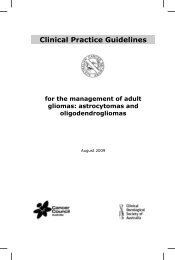Clinical Practice Guidelines for the management of locally advanced ...
Clinical Practice Guidelines for the management of locally advanced ...
Clinical Practice Guidelines for the management of locally advanced ...
You also want an ePaper? Increase the reach of your titles
YUMPU automatically turns print PDFs into web optimized ePapers that Google loves.
12 months in those with more extensive disease. The optimal <strong>management</strong> <strong>of</strong> <strong>the</strong>se patients remains<br />
far from clear. There are no randomised studies addressing <strong>the</strong> role <strong>of</strong> pelvic radio<strong>the</strong>rapy. However a<br />
number <strong>of</strong> retrospective studies suggest that a fractionated course <strong>of</strong> high-dose palliative pelvic<br />
radiation treatment can be extremely useful in obtaining growth restraint and alleviating <strong>the</strong> symptoms<br />
arising from <strong>the</strong> disease process. 71-79 Bleeding (haematuria) responds particularly well. Similar results<br />
were found in a more recent case series. 80<br />
A small subset <strong>of</strong> patients can also present with significant metastatic nodal disease within <strong>the</strong> pelvis,<br />
abdomen, chest and supraclavicular or lower neck region. The enlarged nodes can result in significant<br />
pain or obstructive symptoms due to <strong>the</strong> extrinsic compression on <strong>the</strong> adjacent organs. No randomised<br />
or retrospective studies have specifically addressed <strong>the</strong> role <strong>of</strong> radiation treatment in this setting. It is<br />
unlikely that any such studies will be undertaken.<br />
Evidence summary Level References<br />
Although <strong>the</strong>re are no randomised prospective trials to address<br />
whe<strong>the</strong>r radio<strong>the</strong>rapy has a beneficial effect on incurable prostate<br />
cancer and its s<strong>of</strong>t tissue metastases, <strong>the</strong> question <strong>of</strong> benefit remains<br />
clinically important. There<strong>for</strong>e, nine case series have been reviewed<br />
noting that <strong>the</strong>se all pertain to <strong>locally</strong> <strong>advanced</strong> prostate cancer.<br />
There were no significant publications reviewing s<strong>of</strong>t tissue<br />
metastases.<br />
Recommendation<br />
IV 71-79<br />
Radio<strong>the</strong>rapy can be considered <strong>for</strong> palliation <strong>of</strong> symptoms secondary to <strong>locally</strong> progressive<br />
disease.<br />
Grade D<br />
Spinal cord compression/nerve root compression (with or without surgery)<br />
Spinal cord compression is an oncological emergency. It is a potentially devastating complication <strong>of</strong><br />
metastatic prostate cancer that can result in pain, paraplegia, incontinence and loss <strong>of</strong> independence. It<br />
is not uncommon <strong>for</strong> sequelae <strong>of</strong> metastatic disease to occur in between 1% and 12% <strong>of</strong> patients. 81 No<br />
randomised controlled trials were found that examined treatments <strong>for</strong> spinal cord compression<br />
specifically <strong>for</strong> prostate cancer patients. There<strong>for</strong>e, <strong>the</strong> systematic reviews were broadened to cover<br />
any trials that included prostate cancer patients.<br />
Radio<strong>the</strong>rapy is an effective and well-tolerated treatment <strong>for</strong> metastatic bone pain. It has been <strong>the</strong><br />
cornerstone <strong>of</strong> <strong>management</strong> <strong>for</strong> malignant spinal cord compression (MSCC) <strong>for</strong> decades as it is a noninvasive<br />
approach and associated with relatively low toxicity. Its effectiveness is based largely on<br />
retrospective outcomes from single institution series. There are no randomised trials comparing<br />
radio<strong>the</strong>rapy alone with ei<strong>the</strong>r surgery alone or dexamethasone alone <strong>for</strong> malignant spinal cord<br />
compression. There is one randomised trial <strong>of</strong> 276 patients comparing two fractionation schedules<br />
(16Gy/2f vs 30Gy/8f) that gives outcome data <strong>of</strong> radiation alone. 82 In this trial only 14% <strong>of</strong> <strong>the</strong> entire<br />
cohort were prostate patients.<br />
The Maranzano 82 trial confirms <strong>the</strong> importance <strong>of</strong> radio<strong>the</strong>rapy in <strong>the</strong> <strong>management</strong> <strong>of</strong> spinal cord<br />
compression, with 90% <strong>of</strong> ambulatory patients still walking at one month and 28% <strong>of</strong> non-ambulatory<br />
patients regaining ability to walk. 82 However, regaining ambulation if paraplegic is rare. More than<br />
<strong>Clinical</strong> practice guidelines <strong>for</strong> <strong>the</strong> <strong>management</strong> <strong>of</strong> <strong>locally</strong> <strong>advanced</strong> and metastatic prostate cancer<br />
62



